
 Congratulations! If you're snooping around in the fishing report archives, you must be one of the dedicated anglers who spends the extra time that it takes to become an expert at your craft!
Congratulations! If you're snooping around in the fishing report archives, you must be one of the dedicated anglers who spends the extra time that it takes to become an expert at your craft!
I respect folks who do their homework and that's why I have these reports archived. You can glean a lot of information about seasonal trends and movements of the fish in Northern Minnesota's Itasca Lakes Area. I've always believed that studying the fishing patterns and fish movements throughout the seasons would allow anglers to see the emergence of interesting trends that could help when forming a strategy for an upcoming fishing trip.
I know that you can find plenty of useful information, even in the earliest, silliest fishing reports written during my formative years. That's why I'm going through the entire website and dusting off all of the original fishing reports.
I hope that you will find a tidbit here and there that does you some good and I'd really appreciate hearing your comments and questions. Happy Fishing !! ![]() - Jeff Sundin 218-245-9858 or EMAIL
- Jeff Sundin 218-245-9858 or EMAIL
 Jeff Sundin Fishing Report Archives June 23, 2005 "Summer Heat Wave Sends Fish In New Directions"
Jeff Sundin Fishing Report Archives June 23, 2005 "Summer Heat Wave Sends Fish In New Directions"
This is about as close to the "Normal Summer" as we’ve gotten in the past several years. The rainy season came on schedule and now the hot season appears to be rolling in. Surface water temperatures have risen from the cool sixties up to the high seventy-degree range in about a week. With the warm up we’ve seen accelerated weed growth, a variety of insect hatches and re-locating fish. Moving from spot to spot and checking for "new arrivals" has been the rule of the week. The summer season is upon us.
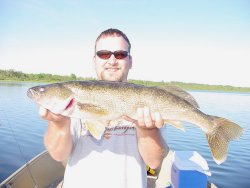 What? You don't like dabbling in the weeds? Try pulling one of these out of a big green Cabbage Bed and you'll be converted for life. In this weed bed, we could see the Walleye moving out as the boat approached. It took a lot of patience, but the rewards were great.
What? You don't like dabbling in the weeds? Try pulling one of these out of a big green Cabbage Bed and you'll be converted for life. In this weed bed, we could see the Walleye moving out as the boat approached. It took a lot of patience, but the rewards were great.
Walleye can still be found in the shallows, especially on windy days. But now the preferred bite is centered on main lake bars and humps. Now that the water is warming up, there are enough minnows and insects on the deeper structures to begin signaling the Walleye to make their move.
We’ve been able to catch some of the deep Walleyes on Jig and Minnow, some on Night Crawlers and some on Leeches. Any day this week that I would have shown up without one of these three baits, would have been a day without a few of the fish we otherwise caught. It seems like we’ve had to change baits almost every time we moved to a new location. Each small group of fish has had it’s own preference.
Shallow water Walleye are inhabiting the deeper portions of the new green weed beds and in areas where weeds meet deeper water, rocks or gravel, there will be at least some fish holding there. When it’s calm, we’ve been able to catch some of these fish by going into the weeds and "flipping" our jigs tipped with either minnows or crawlers, into pockets. These pockets are open spaces between weed clusters that offer the fish an ambush spot to catch bait as it moves through. By concentrating on these openings, you can fish the weeds without getting snagged up.
Use a vertical jigging approach and don’t worry about making long casts. Just fish far enough ahead of the boat to get to the fish before they see you coming and you’ll be able to scratch out several fish from each of the better weed beds.
Crappies, for the most part, have moved out of the shallow areas and are located in and around the deep weeds adjacent to deep open water holes. The better locations will have cabbage; coontail or other mixed weeds and should be fairly close to open water.
During the day, the fish will move to the deeper portions of the weed bed or even out into the open water. At dusk, the fish are moving into the shallower edges and inner sections of the weeds. Some folks are using slip bobbers, but this is an excellent time to catch some of these fish by casting with an ultra-light. Try small Beetle Spins, 1/16-ounce feather jigs or my favorite, a 1/16-ounce jig with a 1-1/2 inch tube tail. Cast into the edges of the weeds and fish S-L-O-W-L-Y back to the boat.
 Larger Northern Pike are showing up on the deeper portions of the new green wed beds, especially on the deeper lakes that have been slower to warm up. Holding toward the deeper edges, they’ve been easier to catch with a jig and minnow. In fact, the largest fish we’ve caught in the past week have all been on a jig/minnow on the deeper weed edges. With all of the sunshine, it’s been tough to get these fish to move up and take spoons or crankbaits, but they would probably cooperate on a gray day with a little rain or chop on the water to make them move. An alternative to the jig/minnow fishing would be to slow troll a large sucker or Chubb along these deeper edges.
Larger Northern Pike are showing up on the deeper portions of the new green wed beds, especially on the deeper lakes that have been slower to warm up. Holding toward the deeper edges, they’ve been easier to catch with a jig and minnow. In fact, the largest fish we’ve caught in the past week have all been on a jig/minnow on the deeper weed edges. With all of the sunshine, it’s been tough to get these fish to move up and take spoons or crankbaits, but they would probably cooperate on a gray day with a little rain or chop on the water to make them move. An alternative to the jig/minnow fishing would be to slow troll a large sucker or Chubb along these deeper edges.
In Alaska, fish like these wouldn't even get a mention. But, fishing jig and minnow with light line and no leader, they are plenty scrappy and loads of fun to catch.
Smallmouth Bass and Largemouth Bass that were on the beds heavy last week are beginning to scatter and move deeper right now. We fished bass in a few areas this Wednesday and found only a few in active Smallmouth remaining on beds. With the accelerated high water temperatures in the shallows, I’d expect to see Bass moving to the deep weedlines soon, if they haven’t made the move already.
 For daytime fishing, try a jerk worm like the popular Slug-go. Cast it out on to the shallow flat portions of the weed beds and work it back to the boat slowly using a twitch and pause motion. During this early part of summer, you’ll get some really explosive hits on these things and if you haven’t tried them before, you owe it to yourself to see how they work.
For daytime fishing, try a jerk worm like the popular Slug-go. Cast it out on to the shallow flat portions of the weed beds and work it back to the boat slowly using a twitch and pause motion. During this early part of summer, you’ll get some really explosive hits on these things and if you haven’t tried them before, you owe it to yourself to see how they work.
Bluegills and sunfish are still in the shallows and active this week, with lots of nice catches being reported on the smaller Bass/Panfish type lakes in the area. Shallow, mixed sand and gravel areas are where these fish spawn and you’ll locate lots of them by cruising along the shoreline and finding the nesting areas visually. Once located, presentation is simple.
If you have an ultra light rod with light 2 to 4 pound test line, casting small jigs toward the shallows and retrieving slowly is the most fun. But bobbers set for shallow water will also get you in to plenty of Bluegill action right now. ![]() Jeff Sundin 218-245-9858 or EMAIL
Jeff Sundin 218-245-9858 or EMAIL
 Jeff Sundin Fishing Report Archive June 15, 2005 "Walleyes Make A Move, Bluegill Action Heating Up"
Jeff Sundin Fishing Report Archive June 15, 2005 "Walleyes Make A Move, Bluegill Action Heating Up"
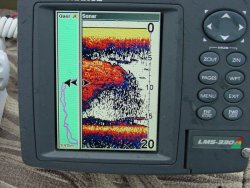 What’s new this week? Well in spite of rainy. Cool weather, the growing season is inching along and fish are making transitions, albeit slower than usual. Even though water temperatures are having a hard time moving out of the low to mid sixties, we are seeing evidence of insect hatches on the mid depth flats in 10 to 16 feet of water. As these insect hatches begin, so does the fish movement toward deeper water.
What’s new this week? Well in spite of rainy. Cool weather, the growing season is inching along and fish are making transitions, albeit slower than usual. Even though water temperatures are having a hard time moving out of the low to mid sixties, we are seeing evidence of insect hatches on the mid depth flats in 10 to 16 feet of water. As these insect hatches begin, so does the fish movement toward deeper water.
Walleyes can still be found in the shallows on most of the Grand Rapids area lakes, but there are increasing numbers of fish using the deeper, main lake structures. Areas that transition from the shoreline out toward main lake bars, humps and mud flats are ideal spots for locating these moving fish. Points that lead out to deep water, emerging weed beds adjacent to deep holes and small humps located near the shoreline are all holding fish, at least temporarily as they move deeper. We’re still catching plenty of Walleye on jig and minnow, but every day I experiment with crawlers and leeches and they are producing fish as well.
Lookie here! Huge schools of minnow like this are common in the area right now. Note the Walleye located in the lower right of the sonar screen. When you see this, it's time to stop and fish. (For larger view, click on image).
With lakes filled literally to the brim with baitfish, it’s been tough to pin down any locations with large schools of fish. Instead, they are broken up into smaller groups and scattered fairly evenly around the lakes. When I locate large schools of minnows there are almost always at least some fish nearby.
Crappie anglers around the Itasca area have noted that most of the shallow spawning fish have moved out into summer cover. Cabbage or mixed Coontail weeds are now holding the fish as they head for deeper water. Like the Walleye, these fish are locating near deep water, but not necessarily out into the wide-open spaces just yet.
A shoreline hole that’s located near deep weeds, brush piles or deeper gravel/rocks will still hold some fish before they start roaming open water during the daytime. Slip bobbers with small jigs are still useful, but small jigs of 1/16 ounce to 1/8 ounce tipped with a minnow or plastic tail and fished vertically in heavier cover will also produce good catches of Crappie.
Bluegills and sunfish are in the shallows and active this week, with lots of nice catches being reported on the smaller Bass/Panfish type lakes in the area. Shallow, mixed sand and gravel areas are where these fish spawn and you’ll locate lots of them by cruising along the shoreline and finding the nesting areas visually. Once located, presentation is simple. If you have an ultra light rod with light 2 to 4 pound test line, casting small jigs toward the shallows and retrieving slowly is the most fun. But bobbers set for shallow water will also get you in to plenty of Bluegill action right now.
 Northern Pike are beginning to show up on the deeper structures too and it’s not been uncommon this week to catch Pike in the 14 to 22 foot depth ranges. With plenty of good green cabbage and large schools of bait building up on the deeper edges, Northern Pike are staging in these areas to feed.
Northern Pike are beginning to show up on the deeper structures too and it’s not been uncommon this week to catch Pike in the 14 to 22 foot depth ranges. With plenty of good green cabbage and large schools of bait building up on the deeper edges, Northern Pike are staging in these areas to feed.
We’ve had better luck picking these fish up on a jig and minnow than by casting for them. We’ve been getting a lot of jigs snipped off, especially by the smaller fish. So, if you want to single out some nice Pike, I’d suggest using a foot long piece of heavy monofilament as a leader. This protects you from most of the bite-off problems, but stays flexible and requires less frequent re-ties than you’d experience with the standard steel leader.
Rig yourself a leader like this to protect from Northern Pike bite-offs. I use 17 pound fluorocarbon line to make the leader. It's clear, remains straight after many fish and it's very tough. Perfect for jigging those deep weedline Pike in early summer.
Smallmouth Bass and Largemouth Bass are on the beds in most lakes now and we’ve seen quite a few males guarding their nest vigorously. Shallow water sight anglers are in their element right now.
Top water baits and jigs with plastic tails are both working well. Releasing fish caught in the shallows near these spawning grounds is considered mandatory by most anglers and if you’re looking for fish to eat, I’d recommend zeroing in on the panfish that are also located shallow at the moment. ![]() - Jeff Sundin 218-245-9858 or EMAIL
- Jeff Sundin 218-245-9858 or EMAIL
 Jeff Sundin Fishing Report Archive June , 2005 "Walleye and Crappie Cooperate In Spite of Turbulent Weather"
Jeff Sundin Fishing Report Archive June , 2005 "Walleye and Crappie Cooperate In Spite of Turbulent Weather"
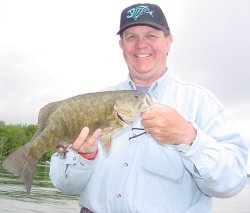 Since my last report, we’ve had another go around with stormy weather. This season it sometimes seems like the fish actually prefer the stormy weather. We’ve had so much turbulence they have gotten used to it and after a fairly stormy week, the only really tricky bite occurred on our best weather day. On that day, we still caught enough fish to make a good trip, but it wasn’t nearly as good as it’s been during the rest of the week and not the kind of fishing folks would have been used to after the past several seasons. When the weather is rainy, windy and otherwise just plain miserable, the fish have been active and there’s been plenty of action. Just like the good old days.
Since my last report, we’ve had another go around with stormy weather. This season it sometimes seems like the fish actually prefer the stormy weather. We’ve had so much turbulence they have gotten used to it and after a fairly stormy week, the only really tricky bite occurred on our best weather day. On that day, we still caught enough fish to make a good trip, but it wasn’t nearly as good as it’s been during the rest of the week and not the kind of fishing folks would have been used to after the past several seasons. When the weather is rainy, windy and otherwise just plain miserable, the fish have been active and there’s been plenty of action. Just like the good old days.
Smallmouth Bass are on the beds in some lakes, but on others they’re still staging to move in. Deeper, clear lakes with cooler water have fish running the sand breaks, rock edges and near the bulrush beds. The warmer lakes have fish on top of the shallow flats keeping the beds safe from predators. Top water plugs, jig & tube combos and jerk worms are all producing some fish. If you like Smallmouth action and want it to continue, release these fish. Particularly the larger fish and any fish caught on the beds.
Crappie fishing has continued to be decent this week. We found Crappies today (Wednesday) in deeper water adjacent to familiar spawning areas. They were suspended in the deeper weed edges where Cabbage and Coontail provided some daytime cover.
Fish that we’ve caught recently are clearly in full scale spawning mode and the females that have eggs remaining are completely ripe and ready to finish off the spring project. During the next week or so, the Crappies will begin to locate in these deeper weed beds. Fishing with a bobber and small jig will catch some Crappies, so will jigs fished vertically in the mixed weeds.
Northern Pike action is steady and fish of small to medium size continue to be both plentiful and willing to bite. Larger fish are also gathering along prime drop off areas where food is plentiful.
Picking a lake with decent size fish is the secret, a little research into the size structure of the Pike in your area will pay off big time. Best baits at the moment are spoons and spinnerbaits. White is always a good choice for spinnerbaits, but we’ve had a bit of luck with the Orange/Black combos too. If you want to single out some of the larger Pike, stick with the larger size spoons and large single bladed spinnerbaits, The extra thump seems to help zero in on larger Northern Pike.
We’ve heard that some folks are finding Bluegills in the shallows as well. I haven’t had the opportunity to take a shot as these, but maybe we can get a better report on them this week.
 Walleyes are acting like fish with plenty of food to eat and in no hurry to feed. So they’re picking and choosing their opportunities and getting active during the peak times. Prime times like sunrise and sunset, windy days and days before storms arrive have all been great times to fish. Nice days, calm and/or sunny weather have been a struggle for most folks.
Walleyes are acting like fish with plenty of food to eat and in no hurry to feed. So they’re picking and choosing their opportunities and getting active during the peak times. Prime times like sunrise and sunset, windy days and days before storms arrive have all been great times to fish. Nice days, calm and/or sunny weather have been a struggle for most folks.
With huge populations of baitfish, primarily young Perch that were hatched last spring (2004) and have filled many of our area lakes to the brim, this could well be a pattern that we see re-occurring throughout the summer. Another complicating factor (for the time being) is that area lakes are all at different stages of development. Shallow lakes that warmed quickly during our April heat wave are already in summer patterns, while deeper cold lakes that didn’t warm quickly in April are still in the early spring patterns.
On calm days, anglers are finding better Walleye action by fishing "prime time" like these boats fishing the sunset.
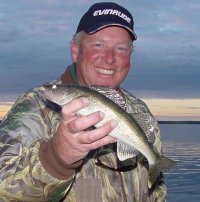 We’ve been making sure to have Minnows, Crawlers and Leeches available on every trip. Make sure you cover all of the bases and don’t get lazy about your choice of locations and bait presentations. We’ve been changing our approach almost daily and whenever we hit on the right combination, the fish have been fairly easy to catch.
We’ve been making sure to have Minnows, Crawlers and Leeches available on every trip. Make sure you cover all of the bases and don’t get lazy about your choice of locations and bait presentations. We’ve been changing our approach almost daily and whenever we hit on the right combination, the fish have been fairly easy to catch.
Most of the Walleye action continues to be centered on the shoreline and newly emerging weed beds. For the most part, weeds have been key to locating Walleyes on most of the lakes we’ve fished. Jig and minnow still provides the best action, but rigging with Crawlers and Leeches is work for plenty of folks too. One trick I’ve noticed is that the fish want to see some movement and when we don’t have a lot of wind, we’ve been better off trolling at a quicker pace and jigging aggressively.
Plenty of eater size Walleyes are coming in this week. Turbulent weather has not slowed the action, nice days with high blue skies have been more of a struggle. Fishing the evening bite will help round out an otherwise lack-luster fishing day. ![]() - Jeff Sundin 218-245-9858 or EMAIL
- Jeff Sundin 218-245-9858 or EMAIL
 Jeff Sundin Fishing Report Archive June 2, 2005 "Summer Weather Arrives, Fishing Action Heats Up"
Jeff Sundin Fishing Report Archive June 2, 2005 "Summer Weather Arrives, Fishing Action Heats Up"
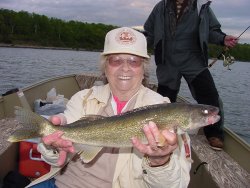 With some of the turbulent spring weather behind us, summer is inching its way into the Grand Rapids Region. Warming water temperatures, Southerly breezes and feeding fish are on the horizon for the up-coming week. Water temperatures have risen to at or slightly above the 60 degree on many of the shallower lakes and temperatures remain in the high fifties in the deeper water lakes. As the temps rise, fish activity is picking up. Action is best when we get a breeze, but savvy anglers are catching some fish even during the calm times.
With some of the turbulent spring weather behind us, summer is inching its way into the Grand Rapids Region. Warming water temperatures, Southerly breezes and feeding fish are on the horizon for the up-coming week. Water temperatures have risen to at or slightly above the 60 degree on many of the shallower lakes and temperatures remain in the high fifties in the deeper water lakes. As the temps rise, fish activity is picking up. Action is best when we get a breeze, but savvy anglers are catching some fish even during the calm times.
Walleyes are considerably more scattered than what we’re used to for this time of year and even though there are some large schools of fish in a limited number of areas, it’s best to search for small schools of fish in off-beat locations. Finding fresh schools of fish is important right now because there’s fairly heavy fishing pressure on many of the more popular spots. Pressure has made fish in these areas spooky and so the bite is on and off, becoming sluggish or even coming to a stand still at times, picking up at prime times like morning, evening or when the wind blows.
 There are still lots of minnows in the shallows, so at least some of the better schools of Walleye remain in these areas to feed. There are also some early signs of fish moving across deeper flats and staging on their way to mid-lake structure. So folks with a bias toward deep water will be in business shortly. Although jig & minnow is still catching fish, rigging with leeches and crawlers is gaining strength and it’s a good idea to start bringing a wider variety of baits on your fishing trips.
There are still lots of minnows in the shallows, so at least some of the better schools of Walleye remain in these areas to feed. There are also some early signs of fish moving across deeper flats and staging on their way to mid-lake structure. So folks with a bias toward deep water will be in business shortly. Although jig & minnow is still catching fish, rigging with leeches and crawlers is gaining strength and it’s a good idea to start bringing a wider variety of baits on your fishing trips.
Crappies are still in spawning areas, but it’s beginning to look like spawning is winding down in the shallower, warmer areas. We’ve caught enough Crappies this week to give me the impression that they’ll stay in the shallows for a little while longer, maybe a week or so, but I wouldn’t count on it to go much longer than that. Next step will be to locate them in mid depth Cabbage weeds, mixed Coontail and rock/gravel bars.
Best presentation is 1/8 ounce or 1/16-ounce jigs tipped with minnows. We’re still using bobbers rather than moving baits, fish are moderately active, but unlike last spring, they’re not really chasing the beetle spins or other faster moving baits just yet. Northern Pike action is shifting from the smaller fish that devour everything in site and some larger fish are starting to show up in the better shallow feeding areas.
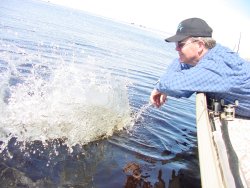 We’ve had some luck casting spoons, but trolling is about even with casting in terms of producing fish. We strongly suggest releasing these larger fish as a way of providing some trophy opportunities for the future. T
We’ve had some luck casting spoons, but trolling is about even with casting in terms of producing fish. We strongly suggest releasing these larger fish as a way of providing some trophy opportunities for the future. T
hankfully, we’ve seen some lakes in our area receive experimental Northern Pike Regulations requiring the release of fish in the 3 to 8 pound size ranges and we’re hopeful that this will result in some places to look for larger fish down the line. In the meantime, if you want to eat Pike, please learn how to remove the Y bones and start utilizing some of these smaller fish. The abundance is incredible and they’re good to eat as well as great fun for youngsters to catch.
An explosive release! We're confident that this fish will provide action for another lucky angler down the road. ![]() - Jeff Sundin 218-245-9858 or EMAIL
- Jeff Sundin 218-245-9858 or EMAIL
 Jeff Sundin Fishing Report Archive May 23, 2005 "Walleye Action Steady In Spite of Stormy Weather"
Jeff Sundin Fishing Report Archive May 23, 2005 "Walleye Action Steady In Spite of Stormy Weather"
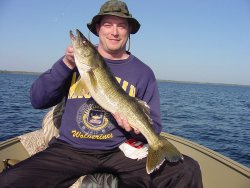 It’s been an interesting first week of fishing this year. Most of our fishing days have been windy, rainy and gray. Luckily, most folks who have been hearty enough to put up with Minnesota’s early season Walleye fishing weather have been rewarded with steady fishing. At times and in prime locations, the Walleye fishing has even been what I would call "hot action". Water temperatures are hovering in the low to mid 50 degree range which is perfect for keeping the fish in the shallows.
It’s been an interesting first week of fishing this year. Most of our fishing days have been windy, rainy and gray. Luckily, most folks who have been hearty enough to put up with Minnesota’s early season Walleye fishing weather have been rewarded with steady fishing. At times and in prime locations, the Walleye fishing has even been what I would call "hot action". Water temperatures are hovering in the low to mid 50 degree range which is perfect for keeping the fish in the shallows.
There’s no doubt that the secret right now is to follow schools of baitfish that are near the shallow flats. When the sun comes or the wind calms down, there are quick movements toward the shallow water. Depths of 5 to 7 feet are working well under these conditions as the minnows and fish move toward shore. With colder temperatures and gray skies, the fish have been moving back out toward the breaklines where we’ve found them in 10 to 14 feet.
Sometimes they have moved even deeper depending on the available structure. We’ve noticed that the fish are making these moves suddenly and within a couple of hours we’ve had to cover several different depths within the same general area of the lake. On Saturday we caught fish first in 10 feet of water, then they moved in to 7 feet, back to 10 feet and eventually back in to 5 feet. When your action slows down, check a different depth before moving too far.
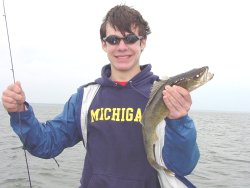 Our presentations are still the traditional early season offerings. Light jigs of 1/16 ounce or 1/8 ounce are best when the fish go shallow. Most of our shallow water jigging has been most effective when we fish the jig tipped with a lip hooked Rainbow Chubb. We’ve been putting a little action on the jig by wiggling the rod tip or lightly hopping it along the bottom. When the fish go out deeper, we’ve been switching to a ¼ ounce jig tipped with a shiner minnow and fishing it more aggressively with a snapping or hard hopping motion.
Our presentations are still the traditional early season offerings. Light jigs of 1/16 ounce or 1/8 ounce are best when the fish go shallow. Most of our shallow water jigging has been most effective when we fish the jig tipped with a lip hooked Rainbow Chubb. We’ve been putting a little action on the jig by wiggling the rod tip or lightly hopping it along the bottom. When the fish go out deeper, we’ve been switching to a ¼ ounce jig tipped with a shiner minnow and fishing it more aggressively with a snapping or hard hopping motion.
Conditions have been changing from hour to hour this week and we've been forced to move in and out constantly to keep track of the moving schools of bait and fish. Changing depths and varying jig weights have helped keep us in the fish.
Crappies are into spring spawning mode and the males are showing their early season black spawning colors. They are on or near spawning beds now so anglers with a passion for early season Crappies should be looking at their favorite shallow spots this week.
With another, turbulent stretch of weather predicted, it might be a perfect time to scope out some of those smaller lakes with protected shallow spawning cover. ![]() - Jeff Sundin 218-245-9858 or EMAIL
- Jeff Sundin 218-245-9858 or EMAIL
 Jeff Sundin Fishing Report Archive May 15, 2005 "The Minnesota Walleye Opener"
Jeff Sundin Fishing Report Archive May 15, 2005 "The Minnesota Walleye Opener"
Continuing the recent tradition of fishing in the cold, snow, wind and rain, The 2005 Minnesota Walleye Opener arrived with a little bit of all the nastiness Minnesota weather can dish out. Most folks never have to endure fishing on days like we had this opener, so I have to give a lot of them credit for toughing it out. Even with high winds and cold temps there were lots of people on the water up here this weekend and for lots of them, the struggle against the weather did not go un-rewarded.
We fished mainly along the first steep drop off edge at about nine feet of water and discovered early in the day, that the fish were relating to schools of minnows that were holding along these deeper pockets waiting to return to the shallows on a warmer day.
We tried a few areas that normally hold fish on opener, but where baitfish were not present, neither were the Walleye. This tells me that the fish have nearly full recovered from the spawning season and are back to actively feeding on the minnows as they spawn in shallow water. Depending on how long the cold weather persists, this could be the signal of an earlier move to deeper water this season.
Our best fishing strategy was to use a 1/16 oz Sneaky Pete with a larger than normal Rainbow Chubb. We hooked the minnows lightly in the lips and fished them using a wiggling or wagging motion on the rod tip. Shiners worked too, but it was clear that the fish preferred the Rainbows on this outing.
Heavy weights and fast jigging was not the ticket and we noticed that during wind gusts or when the boat moved too fast, our bite would virtually stop. Whenever we could go slow and maintain control of these little jigs, we would get back into the action. We finished up a bit earlier than usual this year because of the chilly weather, but not before collecting a nice mess of eating size Walleye.
Looking out the window now, it appears that we’re in for more of the same treatment today and I’ll try to post an update this evening. ![]() - Jeff Sundin 218-245-9858 or EMAIL
- Jeff Sundin 218-245-9858 or EMAIL
 Jeff Sundin Fishing Report Archive April 24, 2005 "20 Days Until The Walleye Opener"
Jeff Sundin Fishing Report Archive April 24, 2005 "20 Days Until The Walleye Opener"
An early jump-start of summer-like weather combined with the early ice out to produce a great run of spawning Walleyes at the Cutfoot Sioux Walleye stripping operation. The week passed quickly for the Minnesota DNR as they completed the operation in short order. In fact, one day this week was at or near record levels with a single day egg harvest of over 625 quarts. With an approximate total egg harvest of 1400 quarts, it’s off to the hatchery in Grand Rapids where the Walleye eggs will grow to barely visible fry before being released into Itasca Area lakes and rearing ponds. We’re about due for another strong year class, especially on some of the lakes that have struggled to produce a year class for the past few seasons. Now we have to hope for a nice warm up in water temperatures over the next couple of weeks so the fry will have good food supplies when they’re sent back into the wild to fend for themselves.
The ice is completely out on all of the Grand Rapids and Deer River area waters so anglers anxious to test their equipment are starting to show up in small numbers. Fishing action in the area is centered on folks fishing for Crappie and Bluegills in the smaller lakes or back bays of the larger ones. Bluegills in particular have been cooperative so far and some of the better action has been fishing from shore in heavily weeded areas with black bottom. Soft mud, coontail, cattails and boat docks are all good places to check. Keeping it simple with small floats, 1/32 or 1/16 ounce jigs and a wax worm is plenty to get you in the ballpark.
There are also some folks looking at the smaller streams and rivers for the spring Sucker run, which is one of my personal favorites. It’s too early to legally take the Suckers by archery or spearing, but when you find a river in the midst of a full scale spawning run, you can catch some of these scrappy fish with a hook and line. The best rig I’ve seen for angling would remind you of a Lindy Rig except using a floating jig tipped with small a worm. Using the sinker to hold your rig in place instead of trolling as you would for Walleyes. Cast your rig toward the edges of current breaks and drag the sinker into place by "feeling" where the current stops pulling on your rig. When you get the knack for finding these "current breaks", the fish do the rest of the work for you. Just let your bait sit still and occasionally one of the passing fish with grab your small worm.
For folks with a little bigger game in mind, the Sturgeon runs on the Rainy River are well, sort of under way. There are some fish biting, but hampered by high winds, cold temps and fast currents, only the toughest anglers are trying their hands at it so far. There are some fish being caught using the traditional bottom weights and night crawlers. River currents are reported to be strong, so prepare with some heavier than usual weights.
Stay tuned as the countdown continues! ![]() - Jeff Sundin 218-245-9858 or EMAIL
- Jeff Sundin 218-245-9858 or EMAIL
 Jeff Sundin Fishing Report Archive April 17, 2005 "27 Days Until The Walleye Opener"
Jeff Sundin Fishing Report Archive April 17, 2005 "27 Days Until The Walleye Opener"
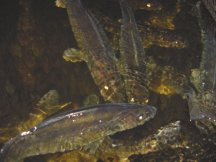 In case you haven’t guessed by now, most of the smaller and medium sized lakes in the 1000 Grand Lakes Area free of ice again. Some of the larger lakes are holding on to sheets of ice, but it won’t last long. They have the Walleye Stripping operation set up at the Cutfoot Sioux Bridge and the Walleye Spawning run is under way.
In case you haven’t guessed by now, most of the smaller and medium sized lakes in the 1000 Grand Lakes Area free of ice again. Some of the larger lakes are holding on to sheets of ice, but it won’t last long. They have the Walleye Stripping operation set up at the Cutfoot Sioux Bridge and the Walleye Spawning run is under way.
Anglers that want to get a jump on the fishing season are finding some panfish action from shore right now and to be sure, the back bays and narrow inlets of your favorite panfish lake are going to be worth a visit during the next week or so.
The best bet has been to stick with small jigs tipped with waxworms about 8 inches below a bobber. The fish that move in early are looking for food, so they move into really shallow water. Many times less than a foot. So while it’s nice to get the boat out for a test drive, the shore anglers probably have an advantage right now.
 We’ve been watching for the early signs of a Sucker run, but with water levels much higher than they’ve been in the past few years, it’s going to take a little longer for temps to warm up enough to get it started.
We’ve been watching for the early signs of a Sucker run, but with water levels much higher than they’ve been in the past few years, it’s going to take a little longer for temps to warm up enough to get it started.
Watch here for a report in the next few days and be sure to check on the Cutfoot Sioux Walleye Spawning Run to see how that project is going this spring. We should have some new photos and news about that tomorrow morning.
Walleyes that swim into the nets at the Cutfoot Sioux stripping station are held overnight and the eggs are taken, fertilized and brought to the hatchery in Grand Rapids where the eggs will hatch and mature under controlled conditions.
Later the fry will be stocked into area lakes, providing anglers with the promise of another good season in just a few short years. ![]() Jeff Sundin 218-245-9858 or EMAIL
Jeff Sundin 218-245-9858 or EMAIL
 Jeff Sundin Fishing Report Archive April 6, 2005 "Breaking Up Is Hard To Do, But It Happens Every Spring. Final Ice Report of 2005."
Jeff Sundin Fishing Report Archive April 6, 2005 "Breaking Up Is Hard To Do, But It Happens Every Spring. Final Ice Report of 2005."
Snow cover throughout most of the 1000 Grand Lakes Area is all but gone. We’ve had some really warm, windy weather during the past few days and although ice is still good for foot travel and ATV’s in some places, conditions are changing daily. Area rivers like the Mississippi, Ball Club, Prairie and Leech Lake River are entirely open including some of the backwaters. On lakes, the narrows and some of the shallow shoreline spots are breaking up already, in fact we’ve seen some of the smaller lakes getting pretty "Black" already, so double-check everything before venturing out for the final burst of spring ice fishing action.
Backwater areas like this one on the Leech Lake River are opening up fast. Most Rivers are wide open, but lakes still have enough ice for one last trip if conditions hold.
Bluegill fishing is still the top pick in my book right now. Smaller lakes make walking easier and this is prime time for these offbeat Bluegill waters. Bluegill locations are along the weedlines with mixed cover. We’ve been finding most of our fish in Coontail weeds in particular. Water depths of 8 to 12 feet have been reliable, but we’ve found them even shallower if there’s good weed cover. Initially, the fish were located near the bottom and later moved up to about half way between the bottom and the surface. These suspended fish were the most active. Some fish were even caught just a foot or two below the surface of the ice.
Best baits have been the Glow Bug, Doodle Bug and Ants tipped with a fresh wax worm. Unlike past trips, a plain jig head or other horizontal type bait didn’t really get them fired up. Lately, all of the best baits have been vertical type presentations. Wax worms that stay on the hook too long and get waterlogged don’t produce as well. Changing the bait often really made a big difference.
Crappie fishing has also been generally good in the Grand Rapids area with anglers on several lakes reporting good fishing. There had been reports of good daytime fishing, but for one reason or another we’ve had to wait until nearly dark before the fish start moving. The depths have shown a clear shift toward shallower, soft bottom areas. OUR SEARCH in water depths of 23 to 30 feet yielded few results. But moving into shallower water of about 16 feet has paid off. Best baits were the now familiar blade type baits like the Demon tipped with a minnow hooked in the dorsal fin.
Perch anglers on Winnibigosh; are now limited to ATV’s as most of the lake access roads are now closed. Perch fishing remains spotty, with most of the reliable fishing located in the Northwest corner of Big Winnie. There are some smaller lakes with fishable perch populations, so for the moment, Perch anglers might want to seek some new, smaller territory to test their skills.
A nice day on the river has it's appeal. The water conditions are changing daily, but there's still time to find a good spot before the season closes.
The Rainy River has drawn a lot of attention from folks with the itch to get out on open water, we made the run up last Friday and were treated to some of the longest lines of parked rigs that we’ve ever seen. The good news is that most folks were helping each other out with rides to their rigs and there were very few slow loaders at the ramps. Water conditions were generally good at that time. Unfortunately, several of the tributaries are now rising, sending lots of murky water into the Rainy. Rising, muddy water usually slows down the action on the Rainy, so some folks are heading upstream towards Pelland while others are pushing out into four mile bay in search of water that’s clearer.
A trip to the Rainy is full of surprises. We watched this fish fight for a long time before the battle was over.
Reports from folks who had been there before us were excellent and we talked to several people who had great fishing a day or two before our trip. For us, fishing was slow in the morning and we had relatively few bites, but as the day grew warmer and we moved further downstream, the action picked up. Eventually, we had a few hours of good fishing that remained steady until about 6:00 PM when it tapered off again. Most fish were caught in the deeper portions of the main channel from 16 to 19 feet of water. A ¼ ounce yellow fireball tipped with a larger fathead and fished with a lazy, lift-drop, produced the most fish. Average size of the fish was 13 to 15 inches with a smattering of larger 19 to 21-inch fish. We only caught one larger fish, although we heard reports from folks who caught some larger fish. ![]() Jeff Sundin 218-245-9858 or EMAIL
Jeff Sundin 218-245-9858 or EMAIL
Home | Current Fishing Report | Saved Fishing Reports | Favorite Lakes | Fishing Articles Section | Recipes | Rates Services | Gift Certificates | Contact | For Sale | Links | Sitemap |
"The Early Bird Fishing Guide" Jeff Sundin - Fishing Blue Books, LLC 715 Byington Ave, LaPrairie, MN 55744 218-245-9858
Email copyright©2018 Fishing Blue Books, LLC All Rights Reserved - last revised 2-13-18